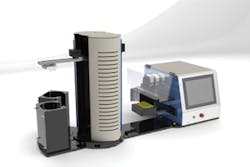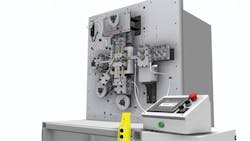Central location. Big table. Lots of presentations, questions, arguments, negotiations, compromises and agreements.
This is where and how the most important planning and designing for any big machine building project usually happens. And it's why traditionally separate design, mechanical, electrical, controls, software and IT departments at many machine builder and customer companies were replaced in recent years by project-oriented groups with cubicles grouped around a common meeting area.
Jim Montague is the executive editor for Control. Email him at [email protected].
Of course, traditional communication also has evolved from face-to-face meetings, telephone and conference calls to include emails and instant messaging, ECAD/CAM files accessible by remote users, and video conferencing via WebEx, SharePoint and others. However, raw computing power now allows colleagues to move themselves and their documents from user-located and maintained servers and software out onto Internet-based environments or cloud-based services, and then pop up as needed on PCs, laptops, Skype connections, smartphones and now iPads and other tablet devices. At the same time, these ECAD/CAM documents and tools are more sophisticated, adding 3D and 4D (time) functions, and incorporating more physical-force representations, simulations and real-time data.
Cooperation Builds Confidence
What's fueling all this virtualization? It's the same old, ever-changing, always-urgent demands from customers and end users. For instance, 60-year-old Force Technology in Brøndby, Denmark, inspects and performs non-destructive testing of critical welds and other components in power, nuclear and chemical plants, offshore platforms, pressure and storage tanks, bridges, pipeline systems, ships, wind farms and other facilities, and builds customized equipment to conduct these required inspections, such as 4x5 m manipulators to check turbines. Although some safety checks can be done when plants are running, many require costly shutdowns, and so Force's devices must be thoroughly tested to work properly the first time. Besides these traditional tasks, its customers' systems and inspection requirements are more complex, and this further challenges its staff and equipment.
"We also develop our own robots, and they used to be fairly simple with three axes for doing steel-block inspections in 2D areas," says Christian Brandt Lauritzen, Force's project manager for its Sensor Innovation division. "Over the years, we began to need robots with six degrees of freedom to inspect welds and components in nuclear plants, such as nozzles set in pipe beds and double curves, so we began to move from special-application robots to off-the-shelf robots. We also do five or 10 testing series of a system, and this requires additional and more precise documentation. To help us work together better, agree on which robots to use, and cooperate during assembly, we needed improved 3D modeling that would let us all see a design at the same time, so we could work on a CAD construction without destroying the work of other team members."
Force already had used Dassault Systèmes' CAD drafting, analytics and real-time digital simulation tools for many years to design and help test each unique inspection device before it's built to meet each client's individual application. So, just over 18 months ago, Force adopted Dassault's Catia PLM Express 3D CAD-based product lifecycle management software, as well as its Delmia Cycle Time Performance digital manufacturing and real-time testing software to design and simulate complex inspection conditions before finalizing its designs.
"We do a feasibility study to see how big the device or manipulator should be, how we plan to get it in, and how we'll need to get it out," Lauritzen says. "We receive details on the geometry of the pipe or object to inspect from the customer, and import this data into our virtualized PLM data repository. We then design the inspection apparatus and use our digital manufacturing tool to simulate it in operation via virtual 3D CAD animation (Figure 1). This makes it easier for everyone to see each other's changes, make sure a design is feasible for construction, and feed knowledge back and forth between the shop floor and the designers, which you just can't see from markups on a piece of paper. In the past, we couldn't see as many problems before a machine was built. With our newer digital manufacturing tools, we can predict any real-world problems early, correct the design, and be sure that it will operate error-free when it's built. This saves time and money, but more importantly it gives us more confidence in our equipment and in each other."
Conspiring With Customers
Once a machine builder's engineers learn to work together more closely, their increased camaraderie can spill over to the user side. For instance, Control Micro Systems (CMS) in Winter Park, Fla., is a laser technology integrator that builds $30,000 to $1 million laser marking and material processing systems. It begins every project by carefully defining each prospective client's manufacturing challenge with an eye toward developing a laser solution. These needs can range from serializing printed circuit boards (PCBs) to drilling time-release pharmaceutical tablets.
"Our collaboration always starts with a problem definition and the potential user sending us samples of their products," says Elliot Taylor, CMS's project manager. "These go to our application lab, which determines the optimum laser, optics configuration and software for each user's needs. Once the completed samples are approved by the user, we can begin to design and assemble the laser, optics, transport, vision and software components into a complete, turnkey solution."
There are usually a dozen engineering disciplines on CMS's on-site design team for each laser system, including software, mechanical, electrical, and the project's originating applications engineer, Taylor adds. "From day one of a project, everyone is involved, aware of what's going on, trying to get all the questions answered, and sorting out any possible booby traps," he explains. "That's just standard operating procedure for us. We begin each job with a kickoff meeting with all the department managers participating. As project manager, I consolidate their inputs, while they watch my back for any potential problems in the details. I also try to get them to make sure I'm not making any mistakes. I also try to manage the interpersonal aspect by keeping everyone talking, information flowing, and everyone smiling."
To aid its staff and client's joint design process, Taylor reports, CMS replaced its former 2D CAD drawings with 3D animated models developed with Dassault's SolidWorks software, such as a fully assembled, burnt-in and tested module of Bosch Rexroth's Cartesian motion system that CMS could just drop into its design to improve assembly time and system testing. "Being able to show a table moving helps our customers understand what we're trying to do, how the machine will work, and what it will cost," Taylor says. "These models also cut our design time. It used to take a day to design an X-Y table, and now it takes about half an hour, which reduces our overall design time by about half a day."
Big-Time Partnerships
Sometimes collaborating with one essential partner not only can shift a team's focus, it can change a whole company's direction. For example, Biorep Technologies in Miami had been building manufacturing equipment since 1995, but it began to take off when the Diabetes Research Institute (DRI) at the University of Miami asked in 2003 if Biorep could build a robotic machine with controlled pressure, adjustable flow rates and complete environmental control to help it isolate, stimulate, nurture, test and analyze insulin-secreting Islets of Langerhans cells from donated pancreases to research better diabetes therapies. This job wasn't easy because isolating islet cells usually requires 20 different devices, including five that have to be automated.
Because DRI needed these pancreatic islet cells to be continuously bathed in glucose or other stimulants to yield useful insulin secretions and research data, Biorep initially combined servomotors, PLCs, HMIs and software from several different suppliers, but found it was very difficult to coordinate all of them. "Until now, automating these kinds of formerly manual tasks and machines was done with several different platforms and programming languages, such as one each for the controller, touchscreen, motor drives and stepper drives," says Felipe Echeverri, Biorep's engineering director. "As our company expanded to 10 employees, this became problematic because having multiple learning curves, lengthy documentation and different communication protocols between platforms was so inefficient."
Biorep uses SolidWorks' 3D CAD modeling software to design its physical machines, and has been using SolidWorks Enterprise product data management (PDM) software and a library of electronic PDM (EPDM) object to help colleagues work together, Echeverri adds. "PDM helps us cooperate because it makes sure that if a design is opened, it can only be changed by an authorized user. It also documents all we do, so we can explain changes later, and retain earlier versions. This keeps us all more organized, and means less headaches for everyone. We also can use the EPDM library to reuse modules and hardware from motors to screws in later designs." The HMIs in Biorep's machines also incorporate TeamViewer software to allow remote access and troubleshooting, he adds.
However, to unify automation and controls development for its Perifusion System, Biorep decided to use National Instruments' LabView graphical system design software, and settled on one platform, LabView and NI's CompactRIO software and hardware, for most of the applications in its robotic secretion analysis machine. Perifusion also uses stepper motors from Schneider Electric Motion USA and EtherNet/IP network communication protocol (Figure 2).
"In only three months, Chris Fronda at VI Design Group used LabView and CompactRIO to create controls for our Perifusion System that include stepper motors for multi-axis motion control, accurate incubator chamber temperature control, and an electronic valve array control for complex fluid handling," Echeverri says. "VI Design developed the software architecture with LabView Real-Time and LabView FPGA modules. They also used LabView SoftMotion Module to simulate our system with actual motion profiles, which allowed our staff to visualize and optimize the design, and evaluate different design concepts before incurring the cost of physical prototypes. VI Design helped us reduce our development time from 12 to three months, and we avoided having to develop custom control software and drivers."
Since releasing it in January 2010, Biorep has sold about 30 Perifusion Systems to academic and pharmaceutical research organizations.
User Becomes Machine Builder
One occupational hazard of all this collaboration on faster and more closely integrated projects is that it can cause some serious role reversals for builders, integrators and suppliers. In fact, some machine builders develop and sell hardware, some suppliers take on system integrator duties, and some end users and their integrators build machines.
For example, Park Manufacturing is a high-volume manufacturer of formed metal parts, light stampings and wire forms. Its production equipment includes a GRM80E slide-forming machine from Bihler, two CNC wire-forming machines from Wafios Machinery, and other slide-formers and kick-press manual forming stations (Figure 3). However, as its older machines aged and its customers came up with new needs and designs, Park decided to add some more advanced controls to its still-reliable equipment, and then add some proximity and laser through-beam sensors to monitor and stop operations as needed.
"We only have 12 staff members, and so the engineering department here is pretty much just me," says George Radcliffe, Park's manufacturing engineer. "We decided to add PLCs and sensors to our older, four-slide machines, so our operators could babysit them less, and focus on quality and setup tasks instead."
|
Face Tools New software and Internet-based methods enabling cooperation by machine builders, engineers and others are arriving thick and fast. In fact, by the time this list is finished there will no doubt be dozens more. So the best plan is to try a few, and have your group members settle on one that seems to serve them best.
|
More recently, however, Radcliffe and his colleagues also began building more of their own customized machine attachments and tooling, and even began installing and programming servomotors onto the main drives and feeds on their machines. "Cams only allow material feed-ins at full or half rotations, but servomotors have different accelerations and allow feeds at one-quarter rotations, and this enables us to make more different kinds of parts," Radcliffe says.
He reports that adding advanced functions and enabling more customized parts is crucial to Park's competitiveness because most simple, high-volume parts were outsourced to Asia during the past 10-12 years. "Sometimes we can't get raw materials for what they're charging for finished parts," he explains. "So we concentrate on working directly with our customers to design and engineer their parts, create better prototypes, hold tighter material and dimensional tolerances, and produce more consistent, better-quality parts."
To achieve these difficult goals, Radcliffe and his tooling technician have used Autodesk's Inventor 2.0 software for about 10 years to design the tooling and machinery they build in-house. "Even on our old four-slide machine, we design custom tooling for each new project, such as the small, progressive die for cutting, stripping or notching the metal," he says. "I also found that I could help the tool room avoid mistakes if we had one Inventor seat there and one in my office connected by Autodesk's Vault Workgroup software. We have great toolmakers who can even make parts without dimensional drawings, but they also appreciate being able to open a design file and import part geometries from the CAD model directly into the machine's Gibbs CAM software.
"Even though our team is only two people located 50 feet apart, our 3D tools let us get inside part designs, and get the details exactly where we want them to be. This means our communication and give-and-take is much easier and faster because there's less wasted discussion in either location. There's only so much detailed design and depth of planning you can do with pencil and paper.
"The benefits of collaborating using 3D design tools are immeasurable for us because we can now take on projects that we couldn't have touched 10 years ago. One of the main strengths of a small company like ours is not so much that we can do tasks faster or more efficiently, but that we can work with the very complex geometries that many manufacturers' parts require these days, and this allows us to compete globally. For example, we're making a specially designed clip that goes on the wheels on 60- and 90-gallon residential garbage bins for a customer in Los Angeles. He ended up coming to us because we were the only shop able to do this job, but he had to have that clip because it made the bins easier to assemble for his customers."








